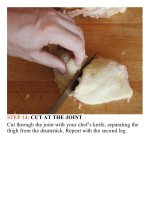The food lab better home cooking through science ( PDFDrive ) 970
Bạn đang xem bản rút gọn của tài liệu. Xem và tải ngay bản đầy đủ của tài liệu tại đây (99.05 KB, 2 trang )
When you drop a green vegetable into a pot of
boiling water, a number of changes occur. First,
blanching destroys enough cellular structure to just
barelytenderizethevegetabletothepointthatithas
lo stits raw, fibrous edge but still retains crunch.
Second, intercellular gases expand and escape from
thevegetable(you’llnoticesmallbubblescomingout
of, say, your asparagus stalks for a moment or two
after dropping them into the hot water).This initial
escapeofgasiswhatcausesthecolorofavegetable
tochangefrompalegreentoavibrantbrightgreen
—the gas pockets that had been diffusing light
suddenly disappear, allowing the full color of the
chlorophyll pigment to stand out.At the same time,
enzymes that would naturally break green pigments
downintobrownonesaredestroyed.
This is why blanched vegetables appear brighter
green and, more important, stay bright green much
longer than raw vegetables. Of course, continue
cookingtoolong,andthechlorophyllwilleventually
breakdownandyourvegetableswillgofrombright
greentoadrabolivegreenorevenbrown.Thegoal
is to effect those changes as quickly as possible,
without allowing time for the chlorophyll to begin
breakingdown.That’swhyyouwanttouseplentyof
water—it retains its temperature better after you
addthevegetables,whichsubsequentlycookfaster.*
Rule#2:BlanchEachVegetable
Separately









